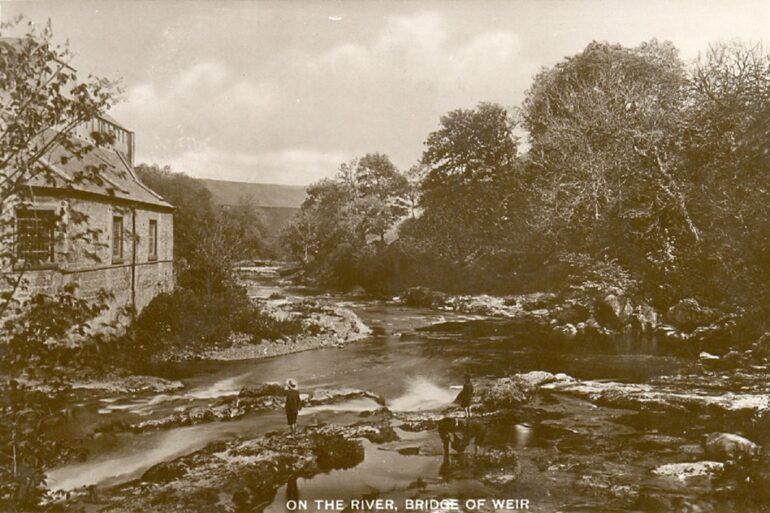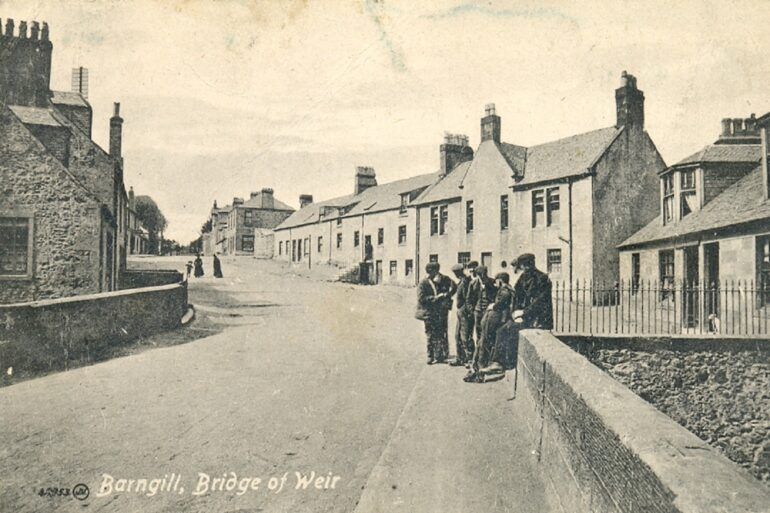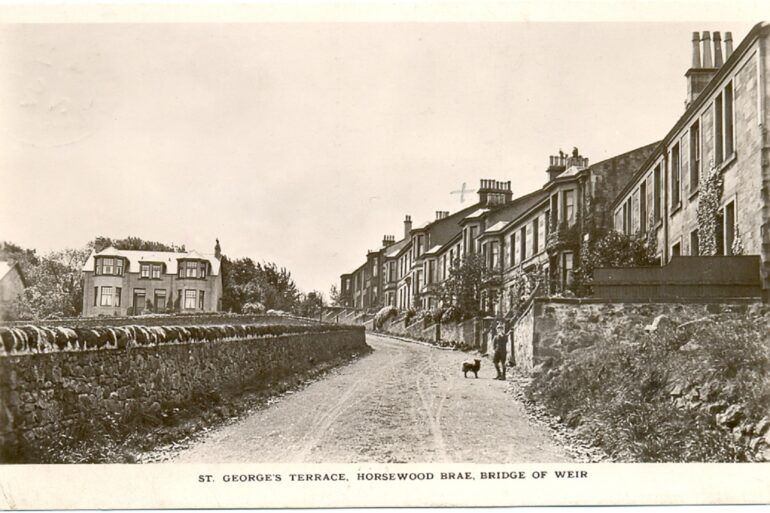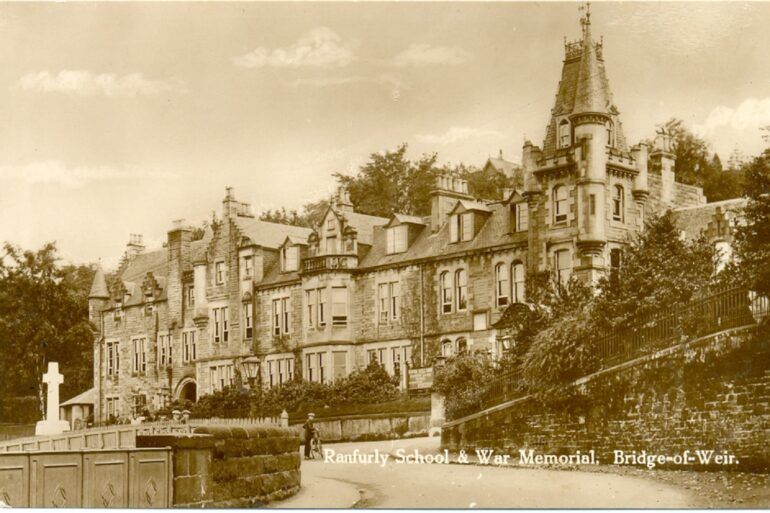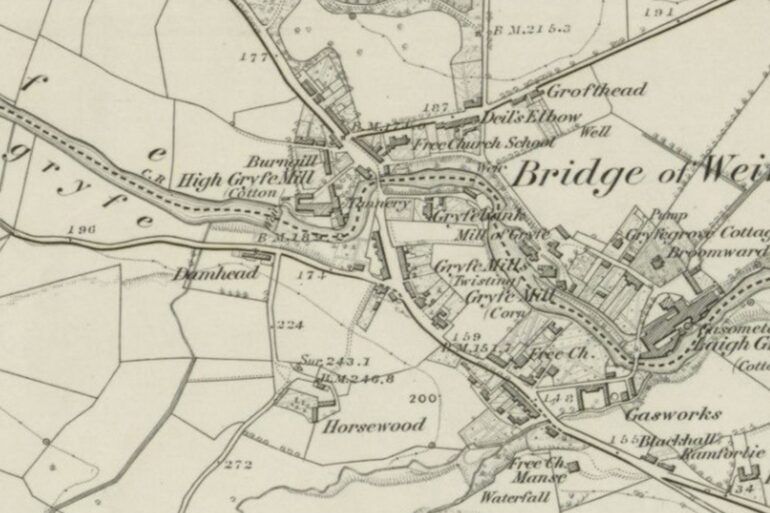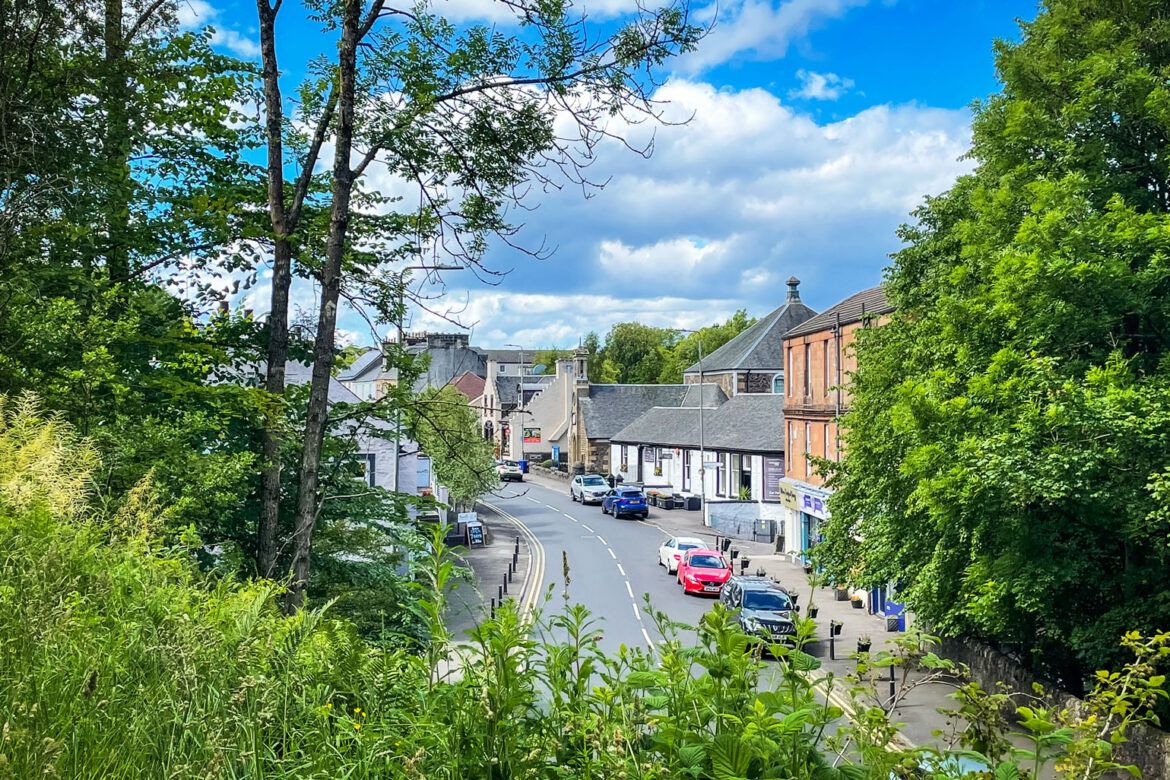One of Renfrewshire’s most sought-after villages, discover more about the history and heritage of Bridge of Weir
Not much is known about the true origins of the village, but thanks to work by Renfrewshire Heritage, we are able to tell a little more of its fascinating story.
Unlike many of its nearby towns and villages, Bridge of Weir’s recorded history as a settlement only dates back as far as the 17th century. However, we know at least a small handful of people lived in the area in the 15th century. One of the area’s most notable historic sites dates from around 1440. Built by the Knox family, the structure was composed of a thick-walled keep alongside a courtyard, houses, and outbuildings. Despite passing into the hands of the 1st Earl of Dundonald in 1665, it soon felt into dereliction.
Cotton and leather
The village was originally called ‘Port o’ Weir’, before it would take on the name we know today. The ‘weir’ in question was a salmon weir. This was stationed on the stretch of the river Gryffe that runs through the village.
It was thanks to the powerful river Gryffe that Bridge of Weir became a name known for its industry.
In Franchise Groom’s Ordnance Gazetteer of Scotland, the village owed ‘its existence to the establishment of two large cotton mills in its vicinity in 1792 and 1793’. While Franchise only mentions two, over time, this would prove to be a drastic understatement.
Everyone was aware of the booming thread industry that was taking off in nearby Paisley. So in 1770 the Speirs family established the Burngill waulk mill. However, instead of manufacturing cotton, this mill worked on the washing and dressing of leather. In doing so, it would kickstart the area’s association with this age-old process. A process that has been a fixture of the town ever since.
Two decades later, Peter Speirs would place an advert in the Glasgow press. It read:
“site for a cotton mill at Bridge of Weir, apply Peter Speirs at the Mill of Gryffe. This mill can never be in back water.”
With that, the Bridge of Weir was alerted to its potential as a place of industry. And the manufacture of both leather and cotton became a staple in the area for generations.
Mills for everyone
Over the following century, mills sprung up all over the village. Rowntrees Lint Mill was described in 1792 as being ‘of excellent construction, and the best frequented of any in the West of Scotland’. Cowan and White’s six-story cotton mill and the Laigh Gryffe mill were also impressive to behold. The late 18th and 19th century saw merchants from all overlooking to harness their share of the river Gryffe’s power. By 1840, there were a dozen separate mill sites of varying size and significance which all drew from that same body of water.
At the height of this period, it was believed that the mills provided employment to over 700 people.
Over time the Burngill Waulk Mill became a fully-fledged leather works. It was still owned by the Speirs family. However, it began to fall on hard times. In 1870, Andrew Muirhead, a leather merchant from Glasgow, purchased the Burngill Tannery for £500.
A new legacy
With his family’s roots in the industry dating back to 1758, Muirhead renamed the site as The Gryffe Tannery. Decades on, Andrew’s youngest son, Arthur, would take ownership of his family’s legacy. And in 1905 he launched his own company known as Bridge of Weir Leather. The tannery had been known for its equestrian leathers. However, Arthur switched focus to upholstery for automobiles and ships. Eventually their work would expand to aeroplanes too.
During both world wars, Bridge of Weir Leather and other local manufacturers produced materials for the army, including boots. By the onset of World War II, the company had over 100 employees.
Just as he’d envisioned, Arthur’s company became renowned for allowing people to travel in comfort. Because of this growing reputation, Bridge of Weir Leather were on the cutting front of luxury automobiles. When the first non-American Ford Model T production plant was established in Manchester, it was Bridge of Weir Leather that they enlisted for its upholstery.
Over the years, many high-end locations have been fitted with the fine craftsmanship that can only be found in Bridge of Weir. From the seats of The House of Commons and the Royal Yacht the QE2. And top-of-the-range luxury McLaren sports cars. By 2014, it was reported that around 90% of the leather produced there is exported to countries around the world.
Arthur and his family had massive contribution to the industrial wellbeing of the town. Furthermore, he also built 40 homes for employees, and gifted nearby land to the village.
Aiding those in need
No-one has left a legacy of aiding those in need within the community quite like William Quarrier. He was a successful shoe merchant from Greenock. And he was deeply affected by the experiences of impoverished and destitute children on the streets of Glasgow. This led him to purchase land at Nittingshill Farm near Bridge of Weir. Alongside architect Robert Bryden, they built what became known as the Orphan Homes.
The Orphan Homes began with just two cottages and a central building. However, this would gradually grow to the point that it boasted 40 cottages, a school, workshops and Mount Zion Church. Plus, a training ship where boys could learn skills for a career in the navy.
Between 1878 and the mid-1980s, over 30,000 children were housed in Quarrier’s children’s village.
Quarriers Village is a fascinating place to visit. Now all privately owned, each building was built to an individual design. William Quarriers vision lives on and Quarriers is one of Scotland’s leading social care charities.
Discover Bridge of Weir for yourself.
Now you’ve ready about the History and heritage of Bridge of Weir, why not visit for yourself. Modern day Bridge of Weir is a village full of great food, lovely pubs and cafes and wonderful walking. With great cycling links, it makes for an ideal destination if you’re exploring National Cycle Route 75.
Additionally, if historic architecture is your thing, Quarriers have put together a self-guided walking tour of the village. Also easily accessed from National Cycle Route 75 the village is a fascinating place to visit.
